SOME LESSER-KNOWN GEMS OF THE CHAMPAGNE DISTRICT
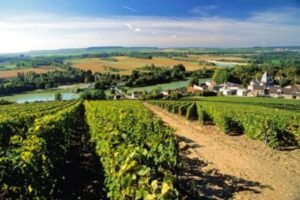
There are many good reasons to plan a visit to the Champagne District. By focussing on the two Champagne “capitals”—the city of Reims and the town of Épernay, the visitor is missing out on so many other attractions of this unique area. This region is rich with World Heritage sites, history and art. It’s easy to spend a couple of extra days divided between châteaux and vineyards, extensive underground cellars—called crayères—hewn out of the chalky earth, wandering through charming little villages, or hiking along quiet country footpaths and forests. Some say it’s out in the countryside with its innumerable tiny villages where you’ll find the true beating heart of the Champagne District.
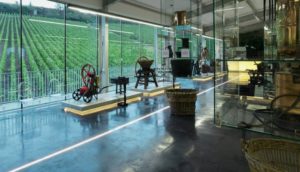
A good place to start exploring further afield and only a 10 minute drive heading east from Épernay, is the town of Aÿ-Champagne overlooking the Marne River in the Vallée de la Marne, a subregion of Champagne where the vineyards are classified as Grand Cru. The town is home to an interesting museum, La Cité du Champagne, where you can discover how this very special wine was born, its history, the special terroir where it thrives and the craft skills of the winemaker. Created by the oldest vigneron co-operative in the area, a visit to the museum is a great opportunity to have an overview of how this most renowned wine came into being. After passing through numerous thematic spaces inside, you will be accompanied through the vineyards to experience and admire the “real live” vineyards. The visit is rounded off with a flourish: a Champagne tasting from Maison Collet. The museum boutique has some enticing goodies too!
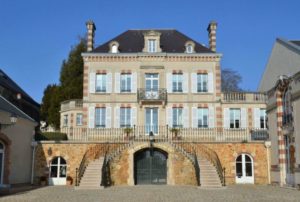
One of the most famous houses in the area is Bollinger, who produce several labels of Champagne under this name, and remains one of the few remaining independent houses. Bollinger has roots in the region dating back to 1525, when one of its founding families owned land in Cramant. In 1822 Jacques Joseph Placide Bollinger moved from Wurttemberg to the Champagne region, initially working for established houses such as Ruinart before setting up his own house in 1829. Around this time, numerous other German winemakers, including the Krug and Heidsieck families, moved to the District.
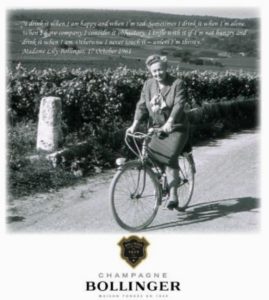
One of the most dynamic marketers of the brand was Lily Bollinger, who travelled the world promoting her house’s Champagne. She left many “quotable quotes” about Champagne, such as “I drink it when I’m happy and when I’m sad. Sometimes I drink it when I’m alone. When I have company I consider it obligatory. I trifle with it if I’m not hungry and drink it when I am. Otherwise, I never touch it—unless I’m thirsty.”
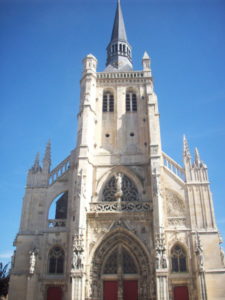
With around 4,000 inhabitants, Aÿ is the largest of the Champagne villages, and almost qualifies as a small town. Due to its size, there’s quite a number of things to see, such as the 15th century High Gothic-style Église Saint-Brice, renowned for the many fine sculptures adorning the western façade. The town has many timber-framed houses, including one that is reputed to have served as Henry IV of England’s fermenting room. In May every year, the town hosts a classical music festival in the church. For those with a passion to learn more about Champagne, this Grand Cru town is the home of Villa Bissinger, which houses the Institut International des Vins de Champagne, and offers courses under the name École des Vins de Champagne.
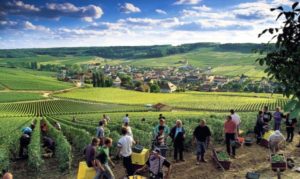
Aside from Bollinger, some of the other great Champagne houses that control vineyards around Aÿ include Moët et Chandon, Mumm, Perrier-Jouët, Deutz, Piper Heidsieck and Roederer. The vineyards are predominantly south-facing and mostly grow Pinot Noir.
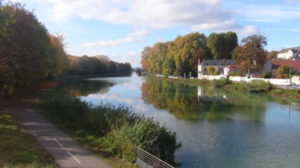
About 3 or 4kms from Aÿ-Champagne is Mareuil-sur-Aÿ. With its vineyards, beautiful wine houses and cellars, this is a typical village of the hillsides of the region, with the added delight of being on the river. The nautical quay built on a side channel of the Marne is lined with small boats including a number of barges and houseboats that can be rented for those who’d like to explore the region’s waterways by boat.
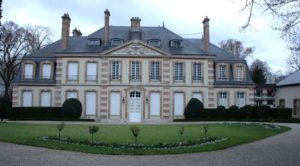
Take a stroll along the tree-lined paths, and you’ll see a lovely view from the canal of the 18th century Château de Mareuil-sur-Ay Montebello, once home to the Ducs de Montebello who founded a Champagne house that survived until the 1930s. The château itself is now a classified historic monument, and numerous large Champagne houses, such as Billecart-Salmon, Bollinger, Krug among others, own vineyards around the town.
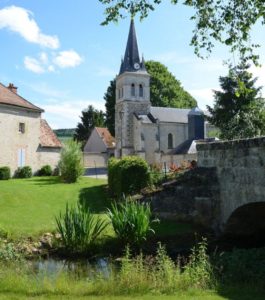
On the slopes above Mareuil-sur-Aÿ, about 5kms to the N.E. is Avenay-Val-d’Or. It’s a much less known village than its neighbours to the south and S.W., but its gentle vine-covered slopes and pretty village, that started as a Roman settlement. makes for a very pleasant detour. Another few kms. up the road where the Livre and Germaine rivers come together is the delightful Fontaine-sur-Aÿ that has managed to preserve its tranquillity and maintain its pastoral charm.
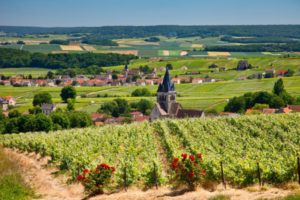
Approx. 11kms to the S.E. of Épernay lies the pretty little village of Avize, surrounded by gentle, rolling hills. The vineyards are located in the Côte des Blancs subregion of Champagne and classified as Grand Cru in the vineyard classification. About 400 winegrowers provide grapes for Moët & Chandon, Veuve Clicquot and Roederer.
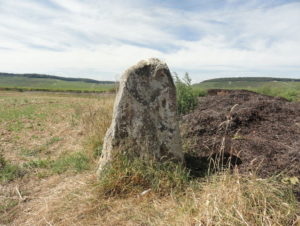
There are traces of prehistoric occupation around Avize, and to the N.E. of the village is an archaeological site marked by the Menhir de Haute Borne, a Megalithic standing stone about 3m tall, some see as being in the shape of a human head, thought to be from the Neolithic Age.
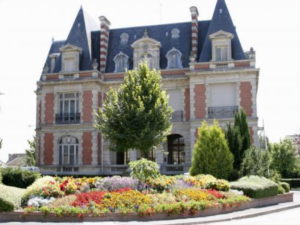
Firstly the Gauls and then the Romans established observation camps at Avize, and settlement spread to the upper reaches of the hills. In the 12th century Avize was a small fortress surrounded by walls and deep ditches, and by the Middle Ages the town was further fortified by walls and ramparts. In 1719 the walls were demolished by the local overlord in punishment for non-payment of feudal dues. With the development of Champagne and the increase in prosperity, Avize began to change, and today we can stroll its streets and admire the many fine, flower-bedecked houses as well as the Château Desbordes, now owned by the municipality.
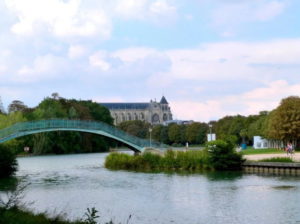
About 30kms east of Avize is one of the major towns of the District, Châlons-en-Champagne, which is the prefecture town for the Marne department and the Champagne-Ardenne region. For centuries it was called Châlons-sur-Marne but was renamed in 1998. Châlons has been an active regional trading centre since Roman times, due to its position on a major trade route. This role continued and flourished during the Middle Ages when it became an important centre for the wool trade.
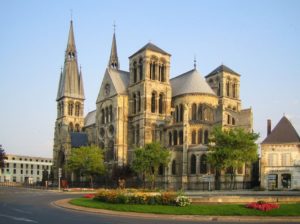
There are a number of interesting historical monuments in the town mostly dating from the prosperous years of the 12th century. Most of these are churches and top of the list must be the Gothic Collégiale Notre-Dame-en-Vaux, regarded as a masterpiece of the style, and also important enough to be listed as a World Heritage Site, as one of the group of churches on the pilgrimage “road to St Jacques de Compostela in France”.
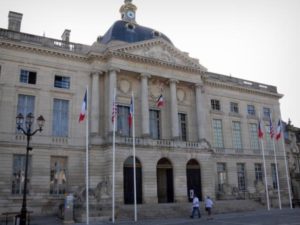
Also have a look at the impressive 13th century Gothic Cathedral of Saint Etienne, the 12th century church of Saint-Alpin, and about one km east of the town centre, the Église Saint Jean, dating from the 11th century, making it the oldest building in Châlons. The town has an imposing 18th century neo-Classical Hotel de Ville, and there are many interesting medieval houses to admire, especially a charming manor house at 10 rue de Chastillon.
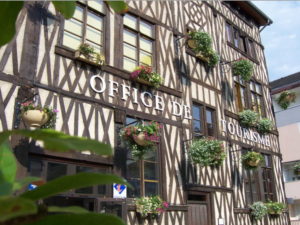
There’s a Protestant Temple, and a 19th century Synagogue that’s well worth looking at for its unusual Moorish design, and an imposing 18th century Hôtel de Ville. It somehow seems fitting that the Tourist Bureau is housed in one of the finest buildings in town, a very attractive colombage (half-timbered) house. Since 2007 Châlons has been designated a City of Art and History, so ask the Tourist Office to mark special points of interest on a town map.
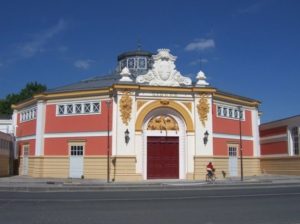
Châlons is the French capital of circus—a much-loved artform in France. Have a look at the beautiful 19th century arena that’s home to a well-regarded institution for research and training, the Centre National Des Arts Du Cirque, that also contributes to the town’s cultural calendar. In June Châlons turns into a giant marquee for the ‘FURIES’ street arts festival, and in December there’s an annual show put on by the centre’s students directed by a leading star of the circus world.
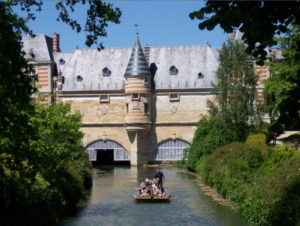
Châlons is situated on the river Marne, and it’s possible to take boat trips that explore the town by its waterways, a lovely way to relax after sightseeing—ask at the Tourist Bureau for info. These waterways cut through the historic heart of the town, passing right under Notre-Dame-en-Vaux, the Château du Marché and the old Convent of Sainte-Marie. The canals offer clear views of the local Champagne-style architecture, lovely old stone embankments and bridges and leafy parks. The boats also run in the evenings from spring to autumn, which would offer quite a different perspective to daytime.
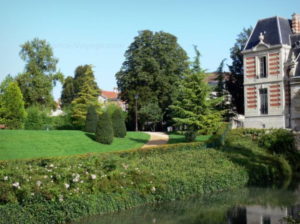
Afterwards, take a stroll to the Petit Jard and its Arboretum, on to the Grand Jard, a French style garden with a traditional bandstand, then across a bridge to reach Jard Anglais, a more open park closer to the river.
Châlons was close to the Western Front in WW1 and was even occupied for a while in September 1914.

About 24kms N.E. of Châlons, at the site of the Champagne front at Spuippes, there’s a most interesting little museum about the war in this region of France, the Centre d’Interpretation Marne 14-18, which uses testimonies of both local civilians and soldiers to resent an absorbing account of warfare and daily life. This is presented along with general information about the build-up to the war, the main offensives and life in the Champagne District behind the front. There’s also an audio-visual reconstruction that places the viewer in the middle of a trench during an assault.

In a fun piece of trivia, for those of us whose memories stretch back a few decades, Châlons is mentioned in that masterpiece of literature by Charles M. Schulz: “It’s the Great Pumpkin, Charlie Brown”, as Snoopy’s crash site after doing battle with the Red Baron.
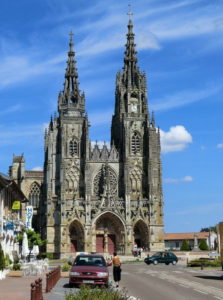
A few kms to the east of Châlons you can visit the Basilique de Notre-Dame at Épine. The church was built from the early 15th century onwards, in the “flamboyant Gothic” style, in a project that took more than 100 years to complete. The entire façade is ornately decorated with a number of gargoyles, such as a crocodile and unrecognisable beasts fighting, as well as the expected statues of saints.
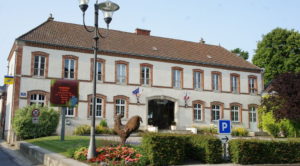
Heading back to Épernay and on to Reims there are a number of small villages to see. Two of which have names that always causes great amusement among English speakers, namely Dizy and Bouzy.
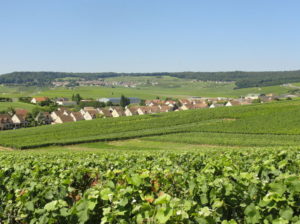
The area is all rolling hills covered with vines with little villages nestling among them. Thanks to the south-facing slopes, the vineyards around Bouzy produce some of the most powerful Pinot Noir wines of Champagne, and a few of them maintain a strong tradition of also producing red wines called Bouzy Rouge, although their appellation is Coteaux Champenois.
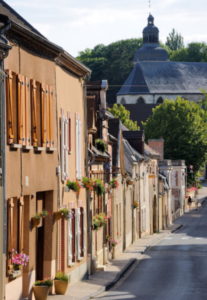
First and foremost of the area’s villages though is Hautvillers, 6kms from Épernay heading up to Reims, perched above a sea of emerald vines and ablaze with forsythia and tulips in spring. Called the berceau (cradle) of Champagne because it’s where the Benedictine monk Dom Perignon (1638-1715) lived, worked, and lies buried, and although it’s something of a myth that the monk invented Champagne, he certainly fully developed the process.
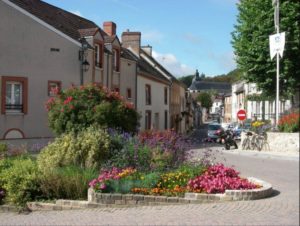
In any case, it’s a lovely village with many houses decorated with over 140 beautiful, medieval wrought iron shop signs that evoke the trades of the past, and narrow streets lined with winegrowers’ houses. You can see the epitaph on Dom Perignon’s grave at the Abbaye de Saint-Pierre d’Hautvillers.
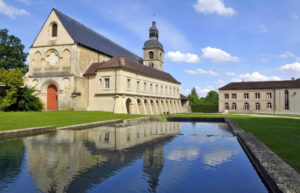
These are just a sample of the pretty villages and attractions in the Champagne District and of course there are so many to explore at your leisure.
It’s also a region that has a good range of accommodation options, not only in Reims, Épernay and Châlons-en-Champagne, but scattered throughout.
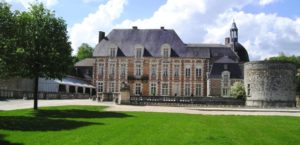
Fancy staying in a château? Check out the Château d’Étoges, 25kms south of Epernay, or perhaps Château de Rilly, at Rilly-la-Montagne, halfway between Reims and Épernay, with a great in-house restaurant that offers a 360 deg. view of the surrounding vineyards.
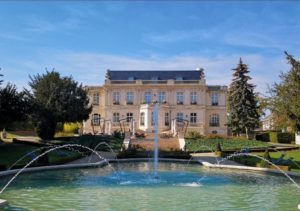
Travelling through the rolling vine-covered hills of the region, perhaps the idea of staying among the vines appeals. Check out Château de Sacy, a beautiful property about 14kms south of Reims in the direction of Épernay.
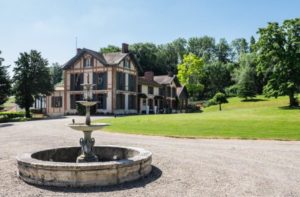
Another good possibility is the Domaine du Chalet, which describes itself as being “between the woods and the vines” near the village of Chigny-les-Roses, in the Montagne de Reims regional nature park. In a beautiful parkland setting with garden, ponds and a glasshouse, there’s also an indoor swimming pool and sauna.
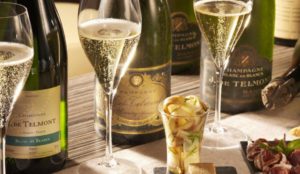
Being France, local cuisine doesn’t take a back seat to the local beverage. It’s hearty, traditional fare such as the outstanding pâté de Reims, and lots of pork dishes, notably sanglier à l’ardennaise (boar) and pig’s trotters à la Sainte-Menehould, other wild game, lots of poultry, and mushrooms collected from the Champagne forests.
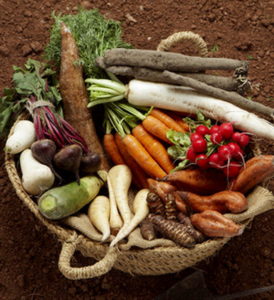
For vegetable lovers, try the Potée champenoise, or La Joute, which resembles a pot-au-feu. There are plenty of local cheeses, such as the chèvres cendrés, a goat cheese with an ash rind from Riceys and Argonne, and of course, the great Bries from around Meaux, west of Épernay.
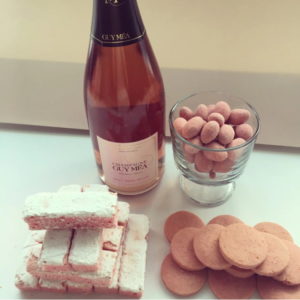
The Champagne Ardenne region is also known for its gingerbread, and don’t forget the famous pink biscuits of Reims. For those with a sweet tooth, a must-try is the local marzipan.
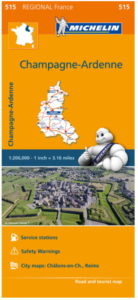
When planning a driving tour around the Champagne District I urge you to purchase a specific Michelin map, no. 515. You can buy it easily online if your local bookshop can’t or won’t get it for you. Michelin are, without doubt, the best maps you can use—we swear by them. Having a sat/nav in a vehicle is great, and nowadays mercifully increasingly common, but you cannot actually plan a trip with just a sat/nav. A good, old-fashioned map indicates all sorts of interesting detour possibilities you mightn’t have considered before. Besides, having a good map spread out on a table at home while you plan is part of the fun of anticipation!
Champagne–the drink that symbolises luxury and celebration, and as Mark Twain once said: “Too much of anything is bad, but too much Champagne is just right!”
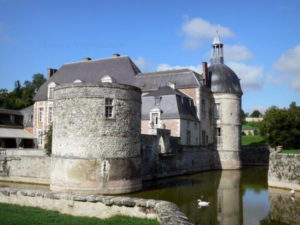


You’ve got to love the quote from Lily Bollinger.
What a way to live life.
Absolutely. She sounds like my kind of girl!
Cheers, although given the topic, salut might be more appropriate!
Cheryl